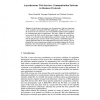Free Online Productivity Tools
i2Speak
i2Symbol
i2OCR
iTex2Img
iWeb2Print
iWeb2Shot
i2Type
iPdf2Split
iPdf2Merge
i2Bopomofo
i2Arabic
i2Style
i2Image
i2PDF
iLatex2Rtf
Sci2ools
WISE
2005
Springer
2005
Springer
Asynchronous Web Services Communication Patterns in Business Protocols
Asynchronous interactions are becoming more and more important in the realization of complex B2B Web applications, and Web services are at the moment the most innovative and well-established implementation platform for communication between applications. This paper studies the existing business protocols for Web services interactions, compares their expressive power, extracts a set of patterns for implementing asynchrony, studies the trade-offs and the typical usage scenarios of the various patterns, and finally proposes a sample application that has been implemented based on these patterns. The application has been designed using a high-level modeling language for Web applications, thus showing that the studied patterns can be applied at a conceptual level as well as directly at implementation level.
| Added | 25 Jun 2010 |
| Updated | 25 Jun 2010 |
| Type | Conference |
| Year | 2005 |
| Where | WISE |
| Authors | Marco Brambilla, Giuseppe Guglielmetti, Christina Tziviskou |
Comments (0)

